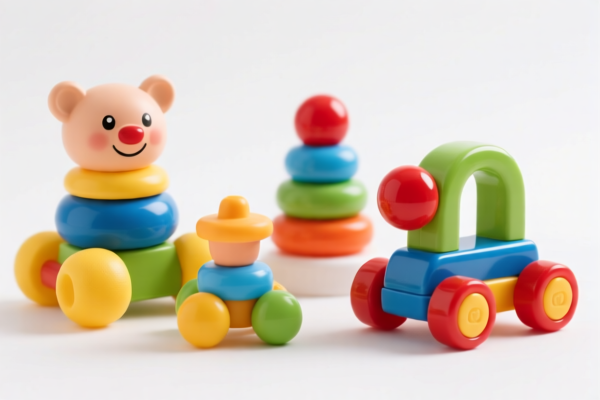| HS Code | Official Doc | Tariff Rate | Origin | Destination | Effective Date |
|---|---|---|---|---|---|
| 9503000071 | Doc | 30.0% | CN | US | 2025-05-12 |
| 9503000073 | Doc | 30.0% | CN | US | 2025-05-12 |




DIY Toys
DIY toys (Do It Yourself toys) encompass a broad category of playthings constructed or significantly modified by the user, rather than being mass-produced. They are characterized by a focus on creativity, personalization, and often, educational value through the building process.
Materials
The materials used in DIY toys are exceptionally diverse, depending on the complexity and intended function of the toy. Common materials include:
- Cardboard: Readily available and versatile, used for forts, vehicles, costumes, and simple structures.
- Wood: Provides durability and allows for more complex construction; often used for blocks, puzzles, and miniature models.
- Plastic: Recycled plastic containers, bottles, or specialized plastic kits are frequently employed.
- Fabric & Yarn: Used for stuffed animals, dolls, puppets, and soft building blocks.
- Paper & Paperboard: Suitable for origami, paper airplanes, and simple games.
- Electronics: LEDs, batteries, small motors, and microcontrollers (like Arduino) are used for more advanced, interactive toys.
- Natural Materials: Sticks, stones, leaves, pinecones, and shells can be incorporated for natural, rustic toys.
- Recycled Materials: A core principle of many DIY toys, utilizing items like bottle caps, egg cartons, and scrap fabric.
Purpose & Function
The purpose of DIY toys is multifaceted:
- Creative Expression: Allow children (and adults) to design and build unique items, fostering imagination.
- Skill Development: Encourage fine motor skills, problem-solving, spatial reasoning, and hand-eye coordination.
- Educational Value: Can teach basic engineering principles, physics, and artistic techniques.
- Personalization: Toys can be tailored to individual interests and preferences.
- Sustainability: Promoting reuse and reducing consumption.
- Entertainment: Providing a fun and engaging activity in itself, beyond the final product.
Usage Scenarios
DIY toys are suitable for a wide range of contexts:
- Home Activities: A popular choice for rainy days or as a family project.
- Educational Settings: Used in classrooms and workshops to teach STEM concepts.
- Therapeutic Applications: Can be used in occupational therapy to develop specific skills.
- Gift-Making: Personalized DIY toys make unique and thoughtful presents.
- Hobby Projects: For individuals interested in crafting, model-building, or electronics.
Common Types
- Cardboard Creations: Forts, castles, vehicles, dollhouses, robots.
- Wooden Toys: Blocks, puzzles, miniature furniture, cars, trains.
- Stuffed Animals & Puppets: Hand-sewn or knitted toys, often personalized.
- Paper Crafts: Origami, paper airplanes, paper dolls, pop-up cards.
- Slime & Playdough: Homemade versions with various textures and colors.
- Electronic Toys: Simple robots, light-up toys, interactive games.
- Recycled Material Toys: Toys made from plastic bottles, egg cartons, and other waste materials.
- Building Kits: Pre-packaged kits with instructions and materials for specific projects (e.g., model airplanes, wooden robots).
- Kinetic Sculptures: Toys that demonstrate principles of motion and physics.
The declared goods, “diy toys,” fall under the category of toys, encompassing tricycles, scooters, pedal cars, dolls’ carriages, dolls, and reduced-scale models. These toys can be working or non-working and include puzzles of all kinds.
The following HS codes are relevant based on the provided information:
- 9503000071: This HS code covers tricycles, scooters, pedal cars and similar wheeled toys; dolls’ carriages; dolls, other toys; reduced-scale (“scaleˮ) models and similar recreational models, working or not; puzzles of all kinds; parts and accessories thereof, specifically categorized as “Childrenʼs productsˮ as defined in 15 U.S.C. § 2052, and labeled or determined by the importer as intended for use by persons under 3 years of age. The tax rate details are: base tariff of 0.0%, additional tariff of 0.0%, and an additional tariff of 30% after April 2, 2025. The total tariff rate is 30.0%.
- 9503000073: This HS code also covers tricycles, scooters, pedal cars and similar wheeled toys; dolls’ carriages; dolls, other toys; reduced-scale (“scaleˮ) models and similar recreational models, working or not; puzzles of all kinds; parts and accessories thereof, categorized as “Childrenʼs productsˮ as defined in 15 U.S.C. § 2052, but intended for use by persons aged 3 to 12 years. The tax rate details are: base tariff of 0.0%, additional tariff of 0.0%, and an additional tariff of 30% after April 2, 2025. The total tariff rate is 30.0%.
Important Note: When declaring these goods, it is crucial to accurately determine the intended age group of the users (under 3 years or 3 to 12 years) as this directly impacts the applicable HS code and associated tariff rate.
Customer Reviews
This page is a lifesaver for anyone exporting DIY toys. The HS code details and tariff rates were all clearly laid out with helpful links.
The page had a lot of useful information, but I was a bit confused about the difference between the two HS codes. More clarification would have been helpful.
I found the section on the purpose and function of DIY toys very helpful. It made me understand why these toys are so popular with both kids and adults.
The explanation of the two HS codes and their tariff rates was very clear. It’s great for someone new to international trade like me.
I needed HS codes for plastic DIY toys, and this page had exactly what I was looking for. The links to the official documents were a huge help.